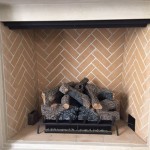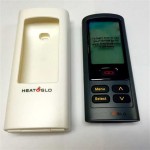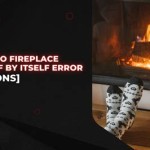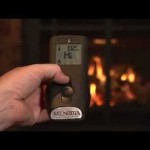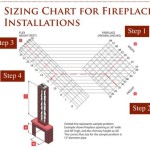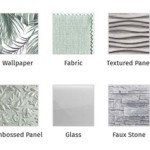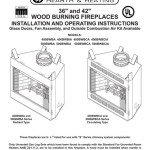Understanding Fireplace Insert Parts: A Comprehensive Guide
Fireplace inserts offer an efficient and aesthetically pleasing way to upgrade a traditional, often inefficient, open fireplace. They essentially transform an existing masonry or prefabricated fireplace into a powerful heating appliance. However, understanding the various components that make up a fireplace insert is critical for proper maintenance, troubleshooting, and potential repairs. This article provides a detailed overview of the key parts found in most fireplace inserts, regardless of fuel type (wood, gas, or electric), highlighting their function and importance.
Essential Components: Firebox and Liners
The firebox is the heart of any fireplace insert. It's the insulated chamber where the combustion process occurs in wood and gas inserts, or where the heating element resides in electric models. The firebox is designed to withstand extremely high temperatures and direct the heat outward into the room. Its construction typically involves heavy-duty materials such as cast iron, steel, or a combination of both. The choice of material impacts the unit's efficiency, durability, and heat retention capabilities.
Within the firebox, liners play a crucial role in protecting the firebox itself and maximizing heat reflection. These liners are typically made of refractory materials like firebrick, ceramic fiber boards, or cast iron. Firebrick, a common lining material, is renowned for its ability to withstand intense heat and radiate it back into the firebox, promoting more complete combustion. Ceramic fiber boards are lighter and offer excellent insulation properties. Choosing the appropriate firebox liner depends on the insert's design and the desired performance characteristics.
Over time, firebox liners can degrade due to thermal stress and physical impact. Cracks, chips, and warping are common signs of wear and tear. Replacing damaged liners is essential to maintain the insert's efficiency and prevent damage to the firebox structure. Neglecting damaged liners can lead to heat loss, incomplete combustion, and potentially compromise the structural integrity of the firebox.
Key System Components: Blowers, Vents, and Flue Adapters
To enhance the heat distribution capabilities of a fireplace insert, blowers are often incorporated. These fans circulate warm air from around the firebox and expel it into the room, significantly improving the unit's heating effectiveness. Blower motors can vary in size and power, directly impacting the airflow. The blower unit itself is typically housed at the bottom or rear of the insert, drawing in cool air and directing it across the heated surfaces.
Vents are critical for both intake and exhaust. Intake vents allow combustion air to enter the firebox, fueling the fire in wood and gas inserts. Exhaust vents (or, more accurately, the flue system) are responsible for venting combustion byproducts safely out of the home. Vents are meticulously designed to comply with safety standards and optimize airflow for efficient combustion and proper ventilation. Regular inspection of vents is crucial to ensure they are free of obstructions and functioning correctly. Blocked vents can lead to incomplete combustion, carbon monoxide buildup (in gas and wood inserts), and overheating.
Flue adapters connect the fireplace insert to the existing chimney flue. These adapters are specifically sized and designed to ensure a secure and airtight connection. In many cases, a flexible stainless steel liner is run from the flue adapter inside the insert, all the way to the top of the chimney. This liner provides a dedicated pathway for exhaust gases, preventing corrosion of the existing chimney and improving draft. The correct selection and installation of flue adapters and liners are paramount for safe and efficient operation. Improper installation can lead to dangerous venting issues and potential fire hazards.
Furthermore, many fireplace inserts include decorative vents or grills on the front of the unit. While aesthetic appeal is a factor, these vents also serve a practical purpose in directing airflow and preventing overheating of the surrounding surfaces. These decorative elements should be cleaned regularly to maintain optimal airflow and prevent dust buildup.
Control and Safety Features: Gas Valves, Thermocouples, and Electric Igniters
Gas fireplace inserts rely on a sophisticated system of controls to regulate gas flow and ignition. The gas valve is a critical component that controls the flow of natural gas or propane to the burner. These valves are typically equipped with safety features that automatically shut off the gas supply in the event of a flameout or other malfunction. Gas valves are precision-engineered to ensure precise and safe fuel delivery.
Thermocouples are safety devices used in gas fireplace inserts. A thermocouple is a heat-sensitive sensor that detects the presence of a pilot flame. If the pilot flame is extinguished, the thermocouple signals the gas valve to shut off the gas supply, preventing gas leaks. Thermocouples require regular inspection and cleaning to ensure they are functioning correctly. A faulty thermocouple can lead to pilot light issues and prevent the insert from operating safely.
Electric igniters, also found in gas fireplace inserts, provide a reliable method for igniting the pilot flame or main burner. These igniters use an electrical spark to initiate combustion. Over time, igniters can fail due to wear and tear or corrosion. Replacing a malfunctioning igniter is often a simple process that can restore proper ignition function. It’s important to note that the electrical components within a gas fireplace insert should only be serviced by qualified professionals.
Electric fireplace inserts, by contrast, utilize heating elements and fans to generate heat. These elements are typically resistive coils that heat up when an electric current is passed through them. A thermostat controls the output of the heating elements, allowing users to adjust the desired temperature. Safety features in electric inserts include overheat protection and automatic shutoff mechanisms. These features prevent the unit from overheating and minimizing the risk of fire.
Moreover, many modern fireplace inserts incorporate remote controls or smart home connectivity. These features allow users to adjust the flame height (in gas inserts), temperature, fan speed, and other settings from a distance. While these features add convenience, they also require a functioning control board and reliable communication between the remote and the insert unit. Troubleshooting remote control issues may involve replacing batteries, checking the signal strength, or examining the control board for damage.
Beyond the core components mentioned, various other parts contribute to the overall functionality and safety of a fireplace insert. Gaskets and seals are used to create airtight conditions around doors and joints, preventing air leaks and maximizing efficiency. Doors provide access to the firebox for cleaning and maintenance. Andirons or grates support the wood in wood-burning inserts, promoting airflow and efficient combustion. Regular inspection and maintenance of all parts are crucial to ensure safe and efficient operation of the fireplace insert.
Understanding the various parts of a fireplace insert and their functions is essential for any homeowner who wants to experience the benefits of supplemental heat while maintaining a safe and efficient heating appliance. Proper maintenance, timely repairs, and adherence to safety guidelines will ensure years of reliable performance and a cozy ambiance in any home.

Pro Series Wood Fireplace Insert Ci2700 Cozy Cabin Regency Parts

Osburnwoodstoves Com Every Part For The Osburn 2000 Insert Select From

Pro Series Wood Fireplace Insert Ci2600 Cozy Cabin Regency Parts

Osburnwoodstoves Com Every Part For The Osburn 2000 Insert Select From

A Plus Inc Lennox Superior Marco Majestic Peterson

Classic Wood Insert H2100 Cozy Cabin Regency Parts

Osburnwoodstoves Com Every Part For The Osburn 3500 Insert Select From

Osburnwoodstoves Com Every Part For The Osburn 1600 Insert Select From

Osburn 2400 Parts

Osburn Horizon Wood Fireplace Parts
Related Posts

